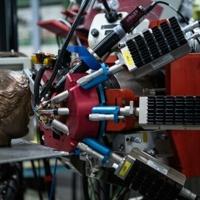Hidden underground below the Louvre in Paris, behind armoured doors, lies a state-of-the-art art lab that seems like a lair of a Bond villain.
The Centre for Research and Restoration of Museums of France (C2RMF) spans across three floors and nearly 6,000 square metres. It houses its own particle accelerator called AGLAE and is staffed with a diverse team of experts including radiologists, chemists, geologists, metallurgists, archaeologists, and engineers.
This 150-strong team examines about 1,000 artworks per year, uncovering the materials and techniques used in their creation, their origins, ages, and any alterations they may have undergone over the years.
Their findings are crucial for restoration work at the centre, as well as at the Louvre, Versailles, and other locations.
Over the years, many renowned artworks such as the Mona Lisa, stained-glass windows of Notre-Dame Cathedral, and Napoleon’s sabre have been analyzed at the lab since its establishment in 1999.
– Similar to ‘CSI’ –
During a rare visit granted to AFP, a team was conducting examinations on an 11th-century bronze sculpture of the Hindu god Vishnu, currently on loan from Cambodia for upcoming exhibitions in France and the United States.
The “Vishnu of Western Mebon”, a masterpiece of Khmer art, was discovered at Angkor Wat in 1936. It is a rare reclining representation of the Hindu god, estimated to have been about six meters long when complete.
Behind heavy lead doors, a team of 10 specialists was using X-rays and 3D scanning to analyze the sculpture. They were also employing techniques like X-ray fluorescence and spectrometry to determine its precise chemical and molecular composition.
Team leader David Bourgarit likened their work to that of NASA or a scientific police force like ‘CSI: Miami’, referring to their investigative approach towards understanding the origins and creation of ancient artifacts.
Further analysis is required to identify certain elements on the sculpture, such as a denser metal present around the eyebrows. The team is also focused on identifying the clay used for the initial mold, which can help locate the statue’s place of origin.
Some fragments of the sculpture may undergo analysis at AGLAE, the only accelerator in the world dedicated to artwork analysis, providing additional data on elemental composition for dating and authentication purposes.
In a room filled with machinery, the accelerator emits a powerful roar as it conducts particle analysis on the artworks, aiding in the scientists’ research.
This sophisticated lab and its cutting-edge technology are instrumental in unraveling the mysteries of ancient artifacts and preserving cultural heritage for future generations.





